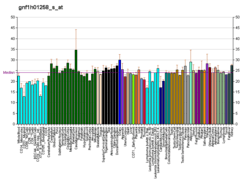Trace amine-associated receptor 8 is a protein that in humans is encoded by the TAAR8 gene.[5][6][7] In humans, TAAR8 is the only trace amine-associated receptor that is known to be Gi/o-coupled.[8]
G protein-coupled receptors (GPCRs, or GPRs) contain 7 transmembrane domains and transduce extracellular signals through heterotrimeric G proteins.[supplied by OMIM][7]
References
- 1 2 3 GRCh38: Ensembl release 89: ENSG00000146385 - Ensembl, May 2017
- 1 2 3 GRCm38: Ensembl release 89: ENSMUSG00000100186 - Ensembl, May 2017
- ↑ "Human PubMed Reference:".
- ↑ "Mouse PubMed Reference:".
- ↑ Lee DK, Nguyen T, Lynch KR, Cheng R, Vanti WB, Arkhitko O, Lewis T, Evans JF, George SR, O'Dowd BF (Sep 2001). "Discovery and mapping of ten novel G protein-coupled receptor genes". Gene. 275 (1): 83–91. doi:10.1016/S0378-1119(01)00651-5. PMID 11574155.
- ↑ Lindemann L, Ebeling M, Kratochwil NA, Bunzow JR, Grandy DK, Hoener MC (Feb 2005). "Trace amine-associated receptors form structurally and functionally distinct subfamilies of novel G protein-coupled receptors". Genomics. 85 (3): 372–85. doi:10.1016/j.ygeno.2004.11.010. PMID 15718104.
- 1 2 "Entrez Gene: TAAR8 trace amine associated receptor 8".
- ↑ Mühlhaus J, Dinter J, Nürnberg D, Rehders M, Depke M, Golchert J, Homuth G, Yi CX, Morin S, Köhrle J, Brix K, Tschöp M, Kleinau G, Biebermann H (2014). "Analysis of human TAAR8 and murine Taar8b mediated signaling pathways and expression profile". Int J Mol Sci. 15 (11): 20638–55. doi:10.3390/ijms151120638. PMC 4264187. PMID 25391046.
Further reading
- Borowsky B, Adham N, Jones KA, et al. (2001). "Trace amines: identification of a family of mammalian G protein-coupled receptors". Proc. Natl. Acad. Sci. U.S.A. 98 (16): 8966–71. doi:10.1073/pnas.151105198. PMC 55357. PMID 11459929.
- Strausberg RL, Feingold EA, Grouse LH, et al. (2003). "Generation and initial analysis of more than 15,000 full-length human and mouse cDNA sequences". Proc. Natl. Acad. Sci. U.S.A. 99 (26): 16899–903. doi:10.1073/pnas.242603899. PMC 139241. PMID 12477932.
- Mungall AJ, Palmer SA, Sims SK, et al. (2003). "The DNA sequence and analysis of human chromosome 6". Nature. 425 (6960): 805–11. doi:10.1038/nature02055. PMID 14574404.
- Gerhard DS, Wagner L, Feingold EA, et al. (2004). "The status, quality, and expansion of the NIH full-length cDNA project: the Mammalian Gene Collection (MGC)". Genome Res. 14 (10B): 2121–7. doi:10.1101/gr.2596504. PMC 528928. PMID 15489334.
This article incorporates text from the United States National Library of Medicine, which is in the public domain.
|
|---|
| TAAR1 | |
|---|
| TAAR2 | | Agonists‡ | |
|---|
| Neutral antagonists | |
|---|
|
|---|
| TAAR5 | | Agonists‡ | |
|---|
| Neutral antagonists | |
|---|
| Inverse agonists‡ | |
|---|
|
|---|
‡ References for synthetic TAAR1 agonists can be found at TAAR1 or in the associated compound articles. For TAAR2 and TAAR5 agonists and inverse agonists, see TAAR for references.
See also: Receptor/signaling modulators |




